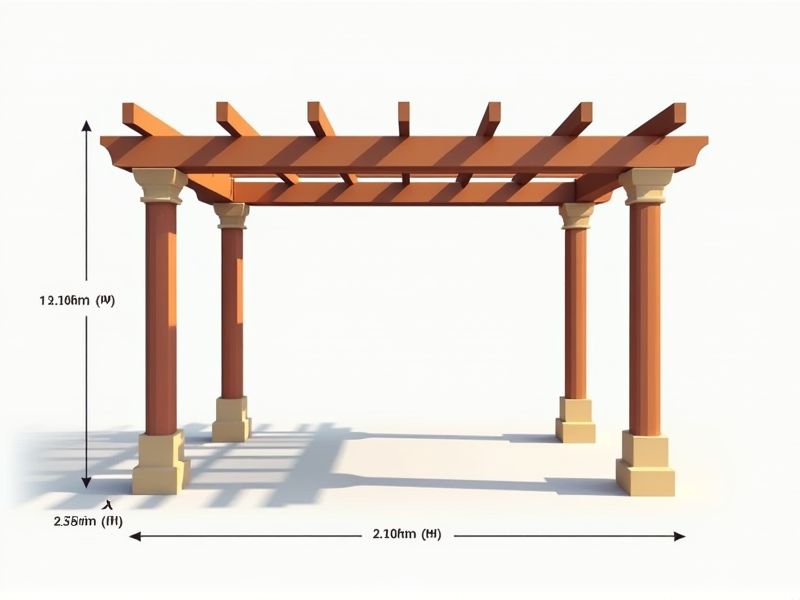
When planning a pergola, standard dimensions typically range from 8 feet by 8 feet for smaller yard spaces to 12 feet by 16 feet for larger outdoor areas. The typical height for a pergola is between 8 and 12 feet, allowing plenty of space for walking and shading. For example, a common and versatile size is 10 feet by 12 feet, providing ample room for seating or dining underneath. It's important to consider the scale relative to your available space and intended use, ensuring the pergola fits comfortably and complements your outdoor environment.
Width
When selecting a pergola, a common standard width is typically between 8 to 12 feet, providing ample space for outdoor gatherings. A wider design, such as 10 to 12 feet, accommodates larger furniture arrangements and enhances comfort. For smaller areas, a width of around 8 feet can create an intimate setting without overwhelming the space. Ensuring your pergola width aligns with your yard dimensions and intended use is crucial for maximizing both aesthetics and functionality.
Length
A typical pergola length ranges from 8 to 20 feet, allowing for versatile outdoor designs. Most homeowners opt for a width between 6 and 10 feet to create a comfortable space for relaxation or dining. Height usually varies between 7 to 10 feet, ensuring sufficient headroom while maintaining an elegant aesthetic. When selecting your pergola, consider materials such as wood or aluminum for durability and weather resistance.
Height
A standard pergola typically stands between 8 to 10 feet in height, allowing for ample headroom while enhancing the outdoor experience. The height can be adjusted based on personal preferences and the intended use of the space, with some designs reaching up to 12 feet for an open, airy feel. Maintaining a height of at least 8 feet ensures that you can comfortably walk beneath without feeling enclosed. This measurement is crucial for creating an inviting atmosphere while also providing adequate shade and structure for climbing plants.
Post Spacing
The standard for pergola post spacing typically ranges from 8 to 10 feet apart, ensuring structural integrity and aesthetic appeal. Using 4x4 or 6x6 posts optimizes stability while supporting the weight of cross beams and roof materials. For larger structures, a maximum spacing of 12 feet can be considered, but this requires additional reinforcement to prevent sagging. Proper post placement enhances both the functionality and durability of your pergola, making it a valuable addition to your outdoor space.
Beam Size
When selecting a pergola, one critical factor to consider is the beam size, which varies based on span and load requirements. Typically, for a residential pergola, beam dimensions can range from 2x6 inches to 2x12 inches, ensuring structural integrity and aesthetic appeal. Proper beam sizing is essential to support climbing plants and withstand weather conditions, with larger beams recommended for spans exceeding 10 feet. Your choice of beam size can significantly influence the overall stability and longevity of the structure, impacting both functionality and visual harmony with your outdoor space.
Rafter Size
The standard rafter size for a pergola typically ranges from 2x6 to 2x8 inches, depending on the desired span and load. For a typical 10-foot span, rafter spacing of 16 inches on center is commonly recommended to ensure structural integrity. When selecting materials, pressure-treated lumber or cedar is recommended for durability against the elements. You can enhance the aesthetics and strength of your pergola by using decorative end cuts and properly securing each rafter with post brackets.
Overhang
The standard design for a pergola typically emphasizes an overhang that provides essential shade and protection from rain. Pergola overhangs can range from 1 to 3 feet, effectively reducing the sun's heat and extending outdoor usage throughout various seasons. Properly designed overhangs enhance the structural integrity of your pergola, utilizing materials like wood or metal that can withstand weather conditions. Considerations for your pergola overhang design also include aesthetics, allowing for integration with garden features while improving the overall ambiance of your outdoor space.
Post Thickness
A pergola's structural integrity significantly relies on post thickness, with a recommended dimension of at least 4x4 inches for standard designs. Thicker posts, such as 6x6 inches, provide enhanced support and durability, especially in regions experiencing heavy wind or snowfall. The choice of material, such as treated wood or aluminum, can also affect the overall resilience and maintenance requirements of the pergola. Your installation should consider local building codes, which may specify minimum post thickness for safety and longevity.
Footprint Size
A standard pergola typically covers a footprint size that ranges between 100 to 300 square feet, allowing flexibility for various outdoor spaces. This coverage can accommodate a variety of functions, from providing shade for dining areas to enhancing garden aesthetics. You might consider a pergola height of around 8 to 12 feet, ensuring ample vertical space while maintaining structural stability. Additionally, incorporating materials such as wood or aluminum can significantly impact durability and style, with wood often requiring more regular maintenance compared to aluminum options.
Clear Space Underneath
A well-designed pergola offers a minimum clearance of 7 to 8 feet beneath its beams, ensuring ample headroom and a spacious feel for users. This clear space underneath not only enhances comfort but also allows for various activities, such as dining or relaxing, without obstruction. When choosing a pergola, consider how its dimensions will complement your landscape, aiming for at least 10-15 square feet of free area per person for optimal enjoyment. Crafting a functional and aesthetically pleasing pergola involves balancing structural integrity with the essential open space beneath.
